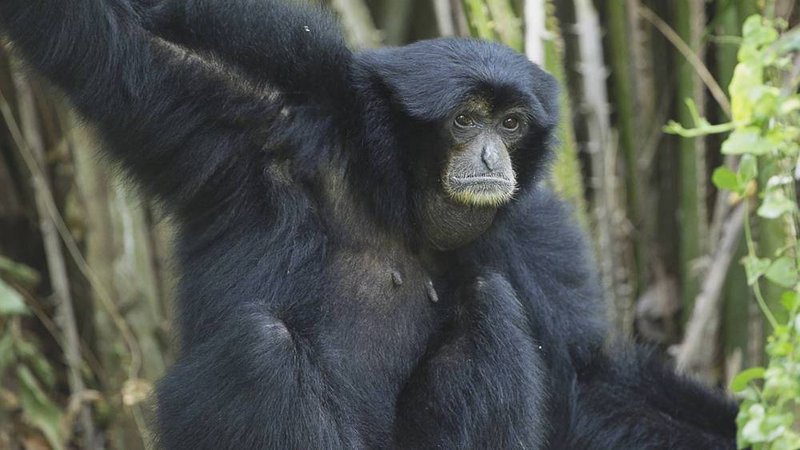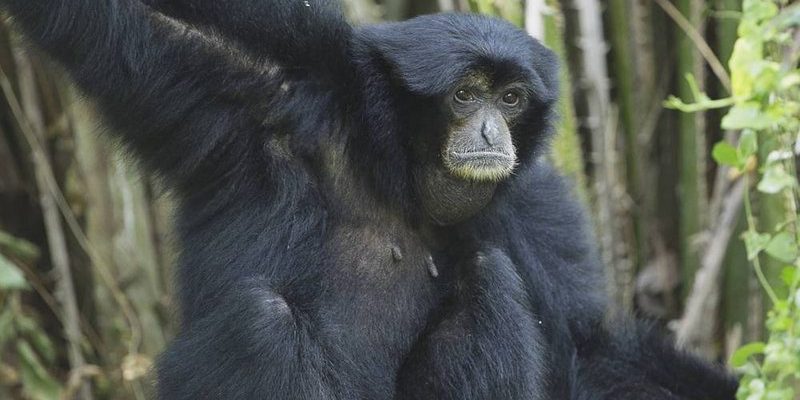
Imagine a creature that swings effortlessly through the treetops, its calls echoing like a haunting melody in the jungle. Meet the siamang, one of the most fascinating primates you’ll ever learn about. These gibbons are not just adept at living in trees; they have a unique charm and vocal abilities that set them apart in the animal kingdom.
The siamang is a large gibbon found in the lush rainforests of Southeast Asia, particularly in countries like Indonesia, Malaysia, and Thailand. With their long arms and sleek bodies, they are perfectly designed for arboreal life. But what truly makes siamang stand out is their impressive vocalization, which serves various purposes, including communication and territory marking.
Whether you’re a nature enthusiast or just curious about wildlife, exploring the world of the siamang reveals much about our planet’s biodiversity. Let’s swing into the details of this incredible creature!
Physical Characteristics of the Siamang
One of the first things you’ll notice about the siamang is its striking appearance. Measuring between 24 to 30 inches in height and weighing between 40 to 65 pounds, they’re among the largest of the gibbon species. Their fur is typically black, which helps them blend into the dark canopy of their rainforest homes.
The most distinguishing feature of the siamang is its throat sac. This large, inflatable pouch can expand significantly, allowing them to produce some of the loudest calls of any primate. You might say their voice can carry for miles! This throat sac not only aids in vocalization but also contributes to their unique appearance, giving them a somewhat regal look.
Another important characteristic is their long arms, which can stretch up to 2.5 times the length of their body. This adaptation is crucial for their swinging locomotion, known as brachiation. Picture them gliding between branches with grace and agility—it’s a sight to behold!
Habitat of the Siamang
The siamang thrives in tropical rainforest environments, ranging from lowland rainforests to mountainous regions. These lush ecosystems provide ample food sources, primarily fruits, leaves, and flowers, which form the mainstay of their diet. You see, these forests are not just homes; they are bustling marketplaces, offering siamang everything they need to survive.
They prefer areas with dense canopy cover, which offers both shelter and safety from predators. The thick foliage allows them to navigate through the trees with ease, making them less visible to threats like large birds of prey or land mammals. Here’s the thing: the health of their habitat is crucial for their survival, as deforestation poses a significant risk to their populations.
Interestingly, siamangs are also known to be highly territorial. They establish their home ranges and will defend them vigorously against intruders. These territories can cover several acres, depending on food availability and population density. It’s like they have their own “neighborhood,” complete with boundaries and vocal guard duty!
Diet and Feeding Habits
Diving into the dietary habits of the siamang reveals their role as essential players in their ecosystem. As primarily frugivores, they consume a variety of fruits, which make up about 70% of their diet. Bananas, figs, and durian are favorites! However, they are also opportunistic feeders, munching on leaves, flowers, and occasionally insects.
During the day, siamangs engage in energetic foraging, using their long arms to reach for ripe fruits hanging from branches. Unlike many primates, they do not travel far from their feeding areas, ensuring a consistent supply of food. This localized feeding strategy helps maintain the health of their habitat by promoting seed dispersal through their droppings, aiding tree regeneration.
Interestingly, their dietary choices can vary based on the season. When certain fruits are in abundance, you might find them gorging while during leaner months, they’ll adapt by consuming more leaves and flowers. It’s a testament to their incredible adaptability and resourcefulness!
Social Structure of the Siamang
Socially, the siamang exhibits a fascinating structure. They typically live in small family groups consisting of a mated pair and their offspring. This close-knit group dynamic promotes cooperation and social bonding. Imagine a family of acrobats, swinging together through the canopy, sharing meals, and grooming each other—that’s the essence of the siamang family!
These primates are known for their strong family ties. Parental care is shared between the male and female, with both actively involved in raising their young. The mother is usually the primary caregiver, but fathers play a crucial role, assisting in feeding and protecting the little ones. This partnership fosters a nurturing environment where offspring learn essential survival skills.
Communication is key within these groups. They use a combination of vocalizations, gestures, and body language to convey their feelings and establish social hierarchies. The siamang’s calls, often described as melodic and haunting, are a crucial part of their social interaction. They might appear to be singing, but it’s all about bonding and maintaining connections!
Vocalization and Communication
Speaking of those mesmerizing calls, the siamang is famous for its vocal prowess. The deep, resonant calls can be heard over great distances, serving various purposes like attracting mates, marking territory, and maintaining group cohesion. Their vocalizations typically begin at dawn and dusk, creating a symphony of sounds that fills the air.
During a duet, a mated pair will harmonize beautifully, each taking on specific pitches and tones that complement one another. It’s a dynamic performance that not only strengthens their bond but also sends a clear message to other siamangs: “This is our territory!” These calls can be so loud that they echo through the forest, almost like nature’s alarm clock.
Interestingly, young siamangs learn these vocal techniques from their parents, honing their skills as they grow. The connection between communication and social bonding is crucial for their survival, as it helps them coordinate movements and alert each other to potential threats. It’s like a well-rehearsed play, where each actor knows their role by heart!
Conservation Status of the Siamang
Unfortunately, the siamang faces significant threats, primarily due to habitat loss and human encroachment. As forests are cleared for agriculture and urban development, these charming primates find their homes shrinking, leaving them vulnerable. It’s a race against time to preserve their habitats and ensure their survival.
The International Union for Conservation of Nature (IUCN) currently classifies the siamang as “Endangered.” This alarming status highlights the urgent need for conservation efforts aimed at protecting their remaining habitats and rehabilitating damaged ecosystems. Various organizations are working to raise awareness about the plight of the siamang, focusing on sustainable forestry practices and habitat restoration.
In addition to habitat protection, breeding programs in captivity are also being established to safeguard the future of these primates. By combining efforts in conservation, education, and public awareness, there’s hope for the siamang to swing into a more secure future, free from the threats they currently face.
Interesting Facts About the Siamang
| Common Name: | Siamang |
| Scientific Name: | Symphalangus syndactylus |
| Habitat: | Tropical rainforests |
| Diet: | Fruits, leaves, flowers |
| Lifespan: | About 30–40 years in the wild |
| Weight: | 40–65 lbs |
| Height: | 24–30 inches |
FAQ
What is the habitat range of the siamang?
The siamang primarily inhabits the tropical rainforests of Southeast Asia, including regions in Malaysia, Indonesia, and Thailand. They prefer areas with a dense canopy that provides ample food sources and protection from predators. These habitats are essential for their survival, as they rely on the rich biodiversity of the rainforest.
How does the siamang communicate with its group?
Siamangs communicate using a variety of vocalizations, gestures, and body language. Their calls are particularly noteworthy, as they can be loud and melodious, serving multiple purposes such as signaling territory and strengthening social bonds. During mating season, a mated pair often engages in vocal duets to reaffirm their relationship and mark their territory.
What do siamangs eat?
The diet of the siamang consists mainly of fruits, which make up about 70% of what they consume. They also eat leaves and flowers, depending on seasonal availability. Their role as frugivores is crucial for seed dispersal in their rainforest ecosystems, helping to maintain the health of their environment.
Are siamangs endangered?
Yes, the IUCN classifies the siamang as “Endangered” due to habitat loss primarily caused by deforestation and human encroachment. Conservation efforts are underway to protect their habitats and promote awareness about their plight. It’s a critical time for these fascinating primates, and active measures are needed to secure their future.
How long do siamangs live?
In the wild, siamangs typically live between 30 to 40 years, although their lifespan can vary based on environmental factors, habitat quality, and threats they face. In captivity, where they are protected from threats and have access to veterinary care, they may live longer, sometimes surpassing 40 years.
What are the key features that distinguish siamangs from other gibbons?
The siamang is distinguished from other gibbons by its larger size, unique throat sac, and vocal abilities. While all gibbons are skilled at brachiation, siamangs exhibit notable agility and can produce some of the loudest sounds among primates due to their throat sac. These features set them apart in both appearance and behavior.
How do siamangs contribute to their ecosystem?
Siamangs play a vital role in their ecosystem as seed dispersers. By consuming fruits and moving through the forest, they help spread seeds, promoting the growth of new plants and maintaining biodiversity. This activity is crucial for the health of the tropical rainforest, making the siamang an integral part of its ecosystem.

